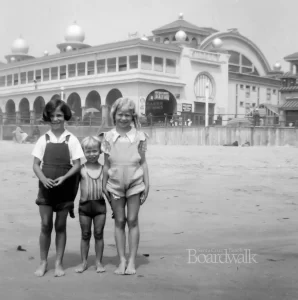
Today, many Boardwalk guests venture inside Neptune’s Kingdom Fun Center for a round of mini-golf. But there’s an older generation of Boardwalk visitors who, upon looking up at the eight blue ceiling girders, can recall fond memories of swimming at the beach – inside the Plunge.
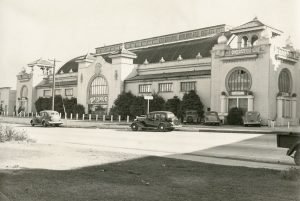
My memories of the Plunge start in my pre-teen and early teen years – the late 1950s and early 1960s. One unique experience I remember was that I could go in and not swim! After ducking into the Plunge’s colonnade entrance (where Laffing Sal is now) and walking past the attendant, I’d find stairs to the balcony and spectators’ gallery on the right.
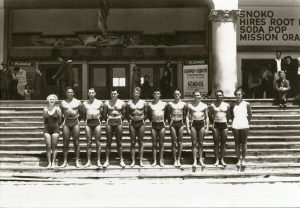
The misty humid air emanating off the heated chlorinated pool water floated upwards. It gave a distinctive tropical feel to the upper reaches of the hanger-like building. Slowly walking around the balcony or sitting on a bench for a few minutes, I could take in the action below. If time permitted and the pools didn’t look too crowded, I would go get my swimming trunks and come back for a “plunge into the Plunge.”

I always had a bathing suit handy in the back of my family’s Bright Spot concession. The entrance fee (I think it was 25¢ back then), would entitle me to an official towel. Patrons could rent a bathing suit, too,

but I never did. Into the pool arena I’d go and walk toward the men’s locker area at the western end of the building.
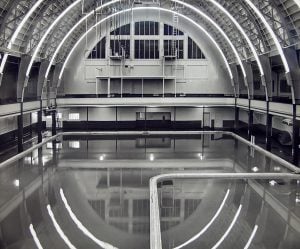
The lockers were layered over several floors. The area was musty, damp and sparsely illuminated. Once changed and street clothes deposited in a locker, I’d secure my belongings. I remember small padlocks on the doors that an employee locker attendant had a master key to. Boardwalk archives reveal there were lockers and dressing areas for 2,500 people.

Once readied in the locker area, back into the pool arena I would go, always with a brother or friend. A bit of a chill caused me to walk smartly along the pool deck to the opposite and eastern end of the pool. Then I’d go down the steps into the 83 degree water – like entering a hot tub today – and quickly snuggle up against one of several spouts of incoming warm water and let it spill over my whole body. It was an instant warmup. Heavenly!

There were two pools. One measured 60ft by 30ft and was used by families with small kids. It went to about 5ft deep. The other L-shaped pool – 65ft by 135ft at its western end – went down to around 12ft. That’s where the diving boards were – the high dive on the beach side and the lower board off the street-side pool deck. Both pools held a combined 408,000 gallons of water. In my earliest adventures in the Plunge, I remember pulling myself along the pool gutter when the pool depth was over my head. After a session of Red Cross sponsored swimming lessons, though, I would venture into the middle area, swimming or paddling with growing confidence.
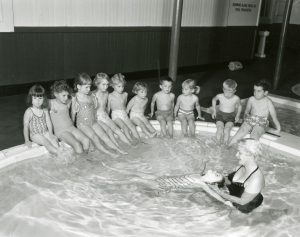
The gutter is also where I went to spit out an accidental gulp of chlorinated salt water! Another right-of-passage was my first dive – or just a jump – off the high diving board. What a thrill!
I recall a few times swimming under water with my eyes open. That was a sure way to get the “Plunge burn,” that stinging sensation from eyes turned red by
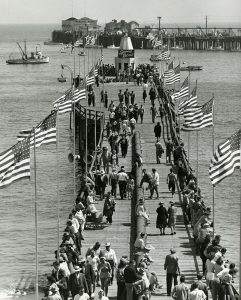
the chlorinated salt water. The burn could last the rest of the day. It hurt to just blink your eyes for a while. Even with eyes shut while in the water, the “burn” was sure to come. In its later years and responding to patron complaints, fresh water was added to dilute the salt water that was pumped from the Pleasure Pier intake pipe, but it still stung!
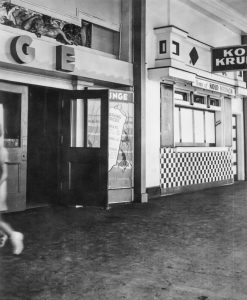
I could spend an hour easily, and might occasionally stay longer depending on who I was with. One swimming lesson I learned was to never swim alone. When it was time to come out of the water, back into the dank lockers I’d go, changing back into my street clothes, and then finally heading back onto the Boardwalk and the Bright Spot concession for a cool soft drink.

I remember seeing trapeze bars and rings hanging from the Plunge ceiling and performing platforms above the building’s balcony level. They were leftovers from the storied Plunge Water Carnivals. I never saw one of those performances, but Boardwalk archives reveal that carnival crowds at these spring and summer spectaculars were “standing room only.”
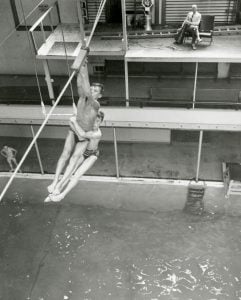
They ran from 1927 to 1945 and were real crowd-pleasers. Talented aerial artists and swimmers – many from the local Santa Cruz community – would regale audiences with amazing performances, choreographed by the Boardwalk’s Warren “Skip” Littlefield, who also acted as master-of-ceremonies. He directed and produced 317 aquatic spectacles over the years. The show’s finale would be a fire dive by Santa Cruz’s own, Don “Bosco” Patterson from high in the rafters of the Plunge ceiling into the deep end of the pool.
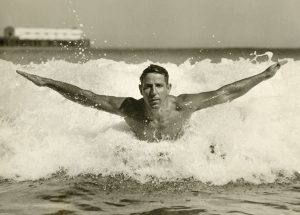
In addition to its entertainment history, the Plunge served practical purposes as well. Many local Santa Cruz youth, myself included, learned to swim in its pools via Red Cross sponsored “Learn to Swim” programs. The US Navy occupied the facility (in addition to the Casa Del Rey Hotel across Beach Street) for two years during World War II. Injured sailors benefited from the healing therapy of warm salt water. A US Army Amphibious Brigade from Fort Ord used the Plunge in 1943 for aquatic training of 1,000 troops before they were shipped to South Pacific action. In the 1950s, Santa Cruz Police Officers learned both to swim and how to perform lifesaving techniques in the Plunge.

In the late Victorian era, indoor pools became a prime attraction at popular vacation locales. During the late 1950s and 60s, modern tastes changed and people became more attracted to the beach and popular surf culture. Caught in this shift, Plunge patronage waned. Seaside Company records reveal that deferred maintenance on the building necessitated that many repairs were needed.

The swell from several large storms in the 1960s seriously damaged the adjoining Pleasure Pier, which held the 18-inch water intake pipe and pump. Instead of repairing the pier, it was dismantled in 1962. Read more about the Pleasure Pier in my earlier post “Remembering the Pleasure Pier”
Once the 1962 summer season concluded, the Plunge’s 56-year history came to an end. Seaside Company officials decreed the pools to be filled – this time with San Lorenzo River sand – and a miniature golf course was designed and installed the next year, taking advantage of the indoor “all-weather” space. As one played that putt-putt course, the
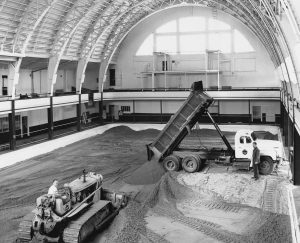
pool’s perimeter gutter was still visible around the outer edge of the playing area – a hint of the swimming emporium’s heyday.
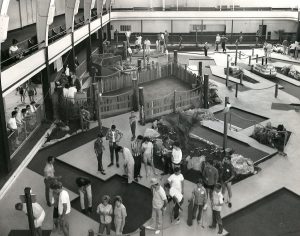
In 1991, the newly rebuilt Neptune’s Kingdom Fun Center opened and utilized a greater measure of the building’s vast space. While guests enjoy mini-golf, pool, ping-pong and the latest arcade games, the blue rounded ceiling girders serve as silent reminders of the glory days of the Plunge.
Got any stories of the Plunge to share?

‘till next time –
Ted



